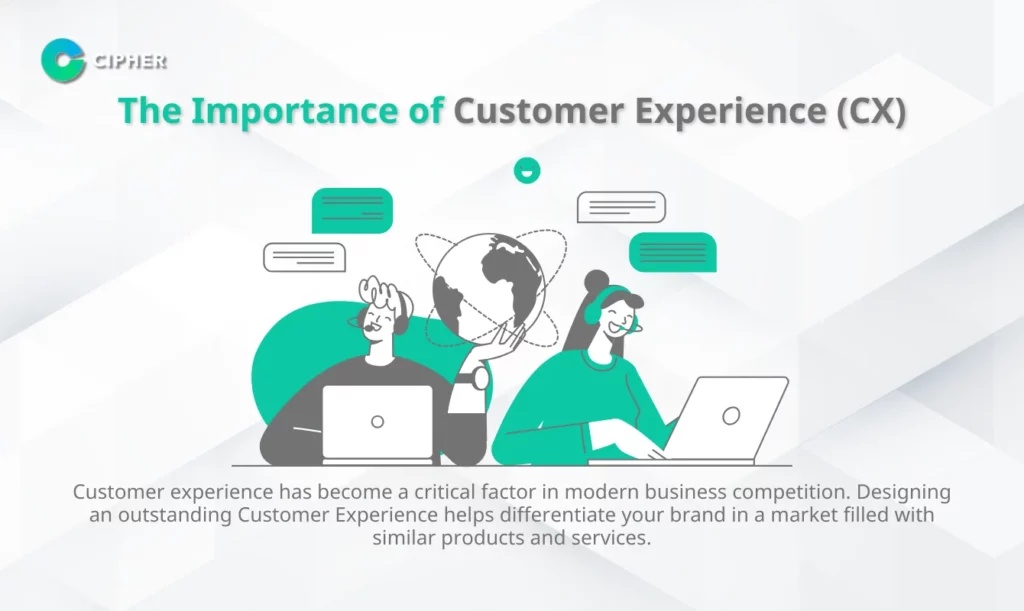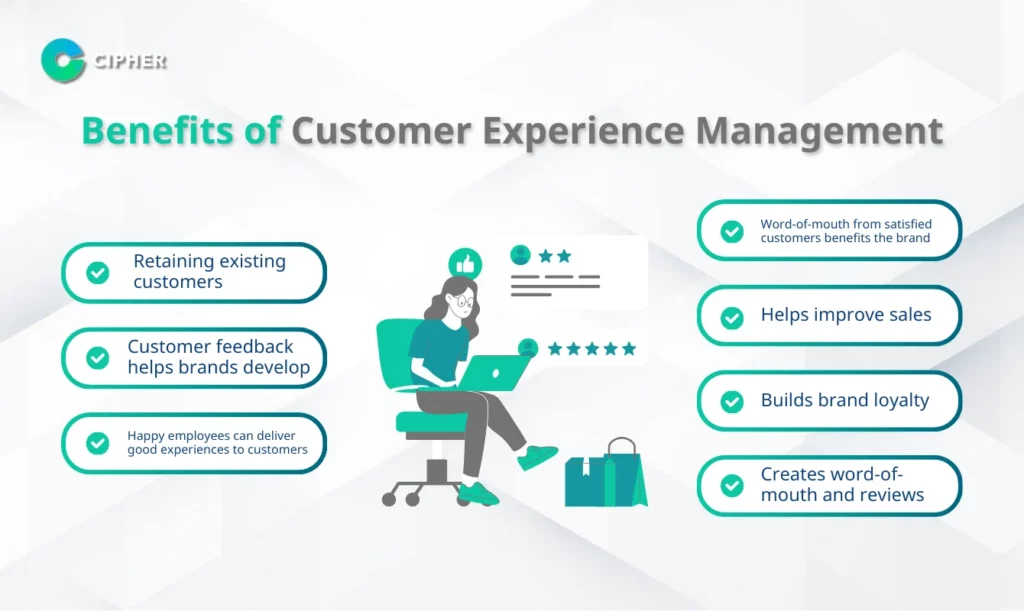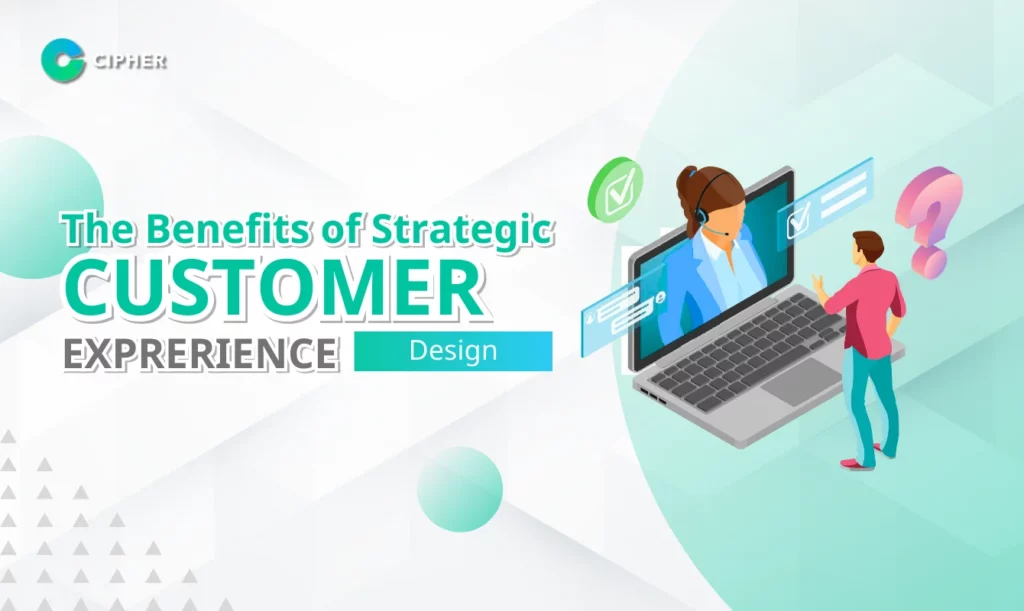Table of Contents
In today’s highly competitive business world, creating brand differentiation is no longer limited to product quality or price alone. It now depends on the experiences customers receive at every touchpoint with your brand. Good Customer Experience design not only attracts new customers but also retains existing ones, stimulates repeat purchases, and creates word-of-mouth that is more effective than any advertising. This article will introduce you to strategic customer experience design and the benefits that will create sustainable business advantages.
The Importance of Customer Experience (CX) in Today's Business Landscape

Customer experience has become a critical factor in modern business competition. Designing an outstanding Customer Experience helps differentiate your brand in a market filled with similar products and services.
According to Gartner’s survey, 89% of businesses worldwide primarily compete on Customer Experience. Furthermore, Forrester found that customers are willing to pay up to 4.5 times more for brands that deliver excellent experiences.
Conversely, if the experience is poor, 17% of customers are ready to stop using a service immediately after just one bad experience, and another 59% will leave after repeated negative experiences. This explains why creating good customer experiences is a key to success in today’s business environment.
What is Customer Experience (CX)?
Customer Experience refers to the overall experience customers receive from interacting with a brand, from before making a purchase decision, through using the product or service, to after-sales support. Creating good CX isn’t just about having good products; it’s about creating positive impressions at every touchpoint between customers and the brand.
CX involves analyzing individual customer data, including purchasing behavior, lifestyle, preferences, interests, social media usage patterns, and concerns they want to address, to present products or services that best meet customer needs. Customer Experience Marketing is therefore the process of using this data to design marketing strategies that precisely address the needs of each customer segment.
The Difference Between CX, UX, and Customer Service
CX vs UX: What's the Difference?
Many people confuse Customer Experience (CX) and User Experience (UX). While these terms are related, they have important differences:
User Experience (UX) focuses on making “products” easy and pleasant to use. The scope of UX includes:
- Content strategy
- Usability
- Information architecture
- Interactive design
- User research
- Visual design
Customer Experience (CX) is responsible for creating experiences at the “brand” level, covering all interactions between customers and the brand. The scope of CX includes:
- Organizational design
- Advertising
- Customer service (pre and post-sales)
- Customer research
- Product delivery
- Ethics
- User experience
In summary, UX is a component of CX. UX focuses on user interaction, while CX looks at the overall business picture to align with customer needs.
CX vs Customer Service: What's the Difference?
Customer Service refers to the period when a business serves customers, including before and after using the service. This encompasses problem-solving, answering questions, providing recommendations, and assisting customers in various ways. Customer Service is only one part of the entire Customer Experience.
Customer Experience has a broader scope, covering all touchpoints from when customers first learn about the brand until they become long-term loyal customers. This includes creating impressive experiences in all aspects, from product design, marketing communications, and product delivery to problem resolution.
The 3 Core Components of Customer Experience
Creating a good Customer Experience consists of three main components:
- Discovery (Exploring and Understanding Customers): Exploring and understanding who your customers are, what they need, and how they behave. The way to achieve this goal is through Customer Segmentation and creating specific characteristics for each group based on available data such as age, gender, and interests.
- Engagement (Creating Participation): Analyzing the collected data to create experiences that meet customer needs, resulting in satisfaction with both products or services and the brand itself. All of this leads to customers receiving positive experiences.
- Delivery (Delivering the Experience): After obtaining and analyzing data, this step involves transforming the analysis into communication strategies to meet customer needs and ensure customer satisfaction.
7 Key Elements of Customer Experience Management
Customer Experience Management (CXM) has seven key elements that help businesses systematically create good experiences for customers:
- Customer Insight: Understanding what customers want, what they like, and how they behave is the first step in knowing what your customer groups truly need and helps create a more detailed picture of the Customer Journey.
- Personalization: Providing personalized experiences to individual customers makes a brand more credible. Using customer data for insight analysis and segmentation, then designing experiences appropriate for each group, helps create customer satisfaction with the brand.
- Consistency: Creating consistent trust across all channels, whether online, offline, or omnichannel. Customers expect seamless and consistent connectivity regardless of which channel they use.
- Research & Development: Every day, trends change rapidly and affect customer behavior. Businesses must constantly monitor, measure, and improve their experience delivery strategies. Failing to develop or adapt to customer needs may result in an inability to meet customer expectations.
- Innovation & Technology: Effectively utilizing technology is crucial for delivering personalized experiences. Contact center systems, chatbots, and CRM tools help businesses respond to customer needs quickly and efficiently.
- Customer Satisfaction: Creating emotional connections with customers is a powerful way to build trust and support. Beyond meeting functional needs, businesses should create memorable experiences that emotionally impact customers, making them remember the brand.
- Employee Engagement: Team members deliver experiences to customers. Investing in training to help teams understand the Customer-Centric concept will enable them to deliver experiences that exceed customer expectations.
Benefits of Customer Experience Management

Investing in customer experience management provides numerous benefits to businesses:
- Retaining existing customers (Customer Retention) costs less than acquiring new ones: Research shows that a 5% increase in customer retention can result in a 25% profit increase. This happens because there’s no need to spend on acquiring new customers, and existing customers who love the brand typically have higher order values.
- Customer feedback helps brands develop: Information from various channels where customers provide feedback is vital for brand development. Listening to customer voices is essential for good CXM.
Happy employees can deliver good experiences to customers: Studies show a strong connection between employee experience and customer experience. Companies with the best customer experiences often focus on listening to employees to improve their experiences. - Word-of-mouth from satisfied customers benefits the brand: When customers are satisfied with their experiences, they are likely to tell others and recommend the brand, which is more valuable than advertising or marketing investments.
- Helps improve sales: Both from existing and new customers, as customers who have good experiences are more likely to make repeat purchases.
- Builds brand loyalty: The existing customer base becomes loyal customers or even brand lovers, which helps create long-term sustainability for the business.
- Creates word-of-mouth and reviews: This has a hugely positive effect on online marketing because it comes from actual users, making it highly credible.
5 Strategies for Creating Good Customer Experience
Creating good customer experiences isn’t accidental but requires clear strategies. Here are five strategies to help you create excellent Customer Experiences:
- Empower employees: Brands that excel at CX begin with their employees. When employees have the authority to make decisions on their own, they can solve customer problems quickly without going through complicated procedures, resulting in customer satisfaction.
- Value employee ideas: Employees are the ones who communicate directly and closely with customers. They are the best communicators of what the brand wants to convey to customers. Listening to employees’ opinions and understandings plays an important role in CX because when you listen, employees are more willing to help customers.
- Use technology to create experiences for customers: Using AI or chatbots can help increase customer satisfaction by allowing them to contact, inquire, and communicate with the brand at any time, making customers feel special. Importantly, these technologies are inexpensive and can be customized in various ways.
- Be ready to receive feedback from all channels: Using an omnichannel approach is an important change in doing business and goes hand in hand with CX. Today’s customers use various channels to contact brands, both online and offline. The smooth flow of customer information is therefore crucial.
- Use a top-down approach: Brands should focus on customers as the most important center. Start CX from the top, putting customers first and using them as the center for planning various strategies. This makes customers feel important.
5 Steps to Prepare Before Implementing Customer Experience Management
Before starting Customer Experience Management, organizations should prepare in various areas:
- Create transparency for the brand: Brand transparency leads to credibility. Customers look for brands with ethics and understanding similar to theirs. Doing business transparently and acknowledging mistakes when problems occur, rather than hiding them, will help customers assess that you are a trustworthy brand.
- Monitor customer feedback: Brands should monitor opinions or voices of customers throughout the Customer Journey. This information will provide important insights that the brand can use for development and improvement.
- Design an efficient omnichannel system: Having a good omnichannel system will help customers interact with the brand through multiple channels, whether social media, email, applications, web chat, or other channels. This system will help staff respond to customers quickly, ensuring consistent and efficient service.
- Plan the Customer Journey: Understanding the customer’s path from the first interaction to post-purchase engagement is key to improving the customer experience. Planning each touchpoint will help you identify problems and develop those points.
- Train the team continuously: An important thing not to overlook is continuous team training because they are the ones who will deliver experiences directly to customers. If team members don’t have the correct knowledge and understanding, they won’t be able to respond to customer needs effectively. Regular training will help team members develop skills and knowledge to handle customer inquiries quickly, accurately, and with deep customer understanding.
7 Customer Experience Statistics That Businesses Should Watch
The following statistics will help you see the importance of Customer Experience design and trends that businesses should pay attention to:
- Challenges in understanding customer needs: Survey results show that 22% of business leaders say understanding customer needs is difficult, and another 21% find adapting to increasing expectations challenging. Customer service teams therefore face difficulties in adjusting CX strategies to respond to constantly changing needs.
- AI has a significant impact on Customer Experience: 86% of CX leaders believe AI will help elevate the experiences they deliver to customers. Companies are preparing to use AI tools to enhance many aspects of customer service, such as personalized responses, sentiment analysis, and need-based recommendations.
- Customers prefer self-service channels: 55% of customers want to use self-service channels (such as knowledge bases or chatbots) rather than waiting in line to talk to staff. Businesses therefore need to develop channels that allow customers to solve problems on their own efficiently.
- Customers expect more personalized communication: 46% of customers look for personalized communication at multiple touchpoints. Businesses should customize various parts of the Customer Journey to build customer confidence.
- Customers expect problem resolution within 3 hours: 67% of customers expect problems to be resolved within 3 hours, with 21% expecting immediate resolution, 23% willing to wait up to one hour for an answer, and another 23% willing to wait up to 3 hours. The faster businesses respond to customers, the more satisfied customers will be.
- Customer Service should connect all channels seamlessly: 79% of respondents confirmed that the important thing is to be available on all channels that customers use. Having a seamless omnichannel system is therefore essential for businesses today.
- Developing customer retention and loyalty is the highest priority: Customer Service leaders prioritize Customer Retention and Customer Loyalty as high as 31%, above other factors. Instead of focusing on short-term offers and discounts, businesses should focus on building strong relationships with customers for long-term success.
What is Experience Design and How to Do It
What is Experience Design?
What Can Experience Design Be Applied To?
- Product Experience Design: Designing experiences for tangible products, from unboxing, reading manuals, assembling, using, to maintenance. Looking at Customer Experience examples from outstanding companies in this area, such as Apple, you’ll see that they prioritize user experience from purchasing products, unboxing, initial setup, to usage and repairs.
- Service Experience Design: Creating customer experiences for various services, which involves more sensory perception – sight, hearing, smell, taste, touch, or even emotional feelings. Examples include designing experiences in coffee shops to make them inviting, organizing sports competitions, or concerts.
- Digital Experience Design (UX/UI): Designing experiences for digital products such as websites, applications, or content management systems to make them easy to use and responsive to user needs. Digital-age Customer Experience Marketing emphasizes creating smooth and impressive online experiences to attract and retain customers.
Principles of Experience Design
Good experience design has important principles:
- Stakeholder Analysis: Analyze all stakeholders involved to ensure that the designed experience will meet the needs of all parties.
- Understanding user/customer experiences: Use tools such as User Journey, Customer Journey, Empathy Map, or Value Proposition Design to gain a deep understanding of users.
- Design the experience: After understanding user needs, use that information to design experiences that respond to those needs using tools such as Service Blueprint or Value Proposition Design.
Conclusion: The Importance of Strategic Customer Experience Design
In today’s highly competitive and rapidly changing business world, strategic Customer Experience design is not just an option but a necessity for businesses seeking long-term success. Creating good customer experiences not only helps increase short-term sales but also builds brand loyalty, stimulates repeat purchases, promotes word-of-mouth, and creates long-term sustainability for the business.
In an era where customer expectations are constantly rising, CX is the key that will differentiate businesses from competitors. Seamlessly connecting all touchpoints, smart use of technology, deep understanding of customer needs, and continuous team development will be important factors that help businesses deliver experiences that exceed expectations and create impressions for customers.
Looking at Customer Experience examples from world-class brands, we see that every brand prioritizes creating different and memorable experiences. Customer Experience means competitive advantage in today’s era because products and services may be imitated, but the experiences customers receive are unique and difficult to replicate.
It’s time for businesses to focus on Customer Experience Marketing and strategic experience design to create differentiation and competitive advantage in rapidly changing markets and build long-term sustainability for the business.




